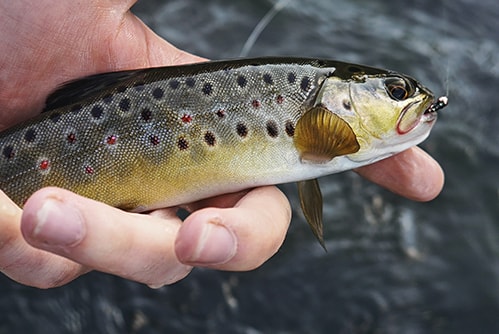Sometimes Simplicity Wins
In a previous article, I wrote about the history of fly-design moving between poles of simplicity and complexity, with a funny story about salmon fishing in Scotland. Sometimes, and more frequently than not, simplicity wins.
Emergers are a class of immature insect in the act of ascending to the surface, attempting to split wingcases, or drying wings, or escaping the remains of a nymphal exoskeleton. Trout, being effi- cient predators by necessity, feed upon the most vulnerable insects, those that, because of a disability or handicap, will never fly away.
During a hatch, there are thousands of individuals in the process of becoming adults. If everything goes as nature intends, they will all look alike. The cripples have one thing in common: theylook different from the successful individuals.
The differences may vary, but there will be some trigger that lets the trout know which ones are vulnerable, so the fish can rise confidently and not waste precious calories in an unsuccessful effort. This is also nature’s way of eliminating less robust individ- uals from the breeding pool. After hatching, the birds take their share, again targeting those individuals that exhibit less than perfect flying ability.
Consider now the standard dry fly, with hackle, wings, body and tails, tied on a metal hook which often breaks the water surface. Can you see your fly on the water amid a hatch of insects? If you can, then your fly doesn’t look like the naturals. The trout will also notice these irregularities and perhaps eat your fly. Ironically, the take is precisely because all of your ingenuity to craft the right silhouette, match color and size, and simulate movement creates just the opposite impression to the fish. The fish recognizes that your fly is a fake, but sucks it in because it won’t fly away. I think it’s terribly humbling to consider this, but it leads to a clearer understanding about what makes a great emerger imitation.
If any irregularity in the natural causes it to be targeted by trout, the more general and simple we can make those irregularities, the better. With fewer elements in each fly, we can concentrate on getting the colors and size right. The goal is to convince the trout that our imitation is a member of the same species that’s hatching, but also that it is crippled.
Soft hackle flies do exactly that, provided the body is the same color as the natural’s underbody, and the hackle is soft and sparse enough to get wet and simply lie along it. Don’t worry about flota- tion. Even wet, most soft hackles will stay in the film, despite the hook point. By the way, make sure you tie them on light weight hooks. Are your soft hackles hard to see on the water? I hope so. You may not be able to see the fly, but you can watch your tippet for a tell-tale twitch, or lift your rod tip if you see a rise where you think your fly is.


